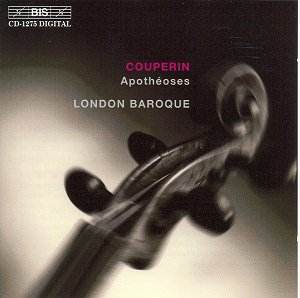François
Couperin often described as 'Couperin le grand' was the nephew
of Louis, and he ranks as the most important member of this famous
musical dynasty. It was towards the close of the 17th century
that his compositions began to make his reputation posthumously.
However during his lifetime his talents were recognised when in
1702 he received the fomal honour of the title 'Chevalier de l'Ordre
de Latran'.
The
programme on this imaginatively compiled collection is dominated
by two of Couperin’s most inspired works, both entitled L’Apothéose’,
and both therefore are works indebted to the concept of homage.
The point behind these was that the composer believed that the
art of music would benefit from the blending of the French and
Italian styles. In which regard it should not be forgotten that
the great Monsieur de Lully, the master of the previous generation,
hailed from Italy.
The
more ambitious of the two pieces is that linking to Lully, but
the Corelli piece is not without its merits. The concept has Corelli
elevated to the deity on Parnassus, and he eventually gives thanks
when he is positioned next to Apollo. Across its fifteen-minute
span the music is admirably balanced both in pacing and in formal
characteristics. Charles Medlam leads an excellent performance,
and here, as elsewhere, the recorded sound is exemplary, at once
clear and atmospheric.
However,
it is with L’Apothéose de Lully that Couperin reaches to
higher levels of inspiration. The pacing of the whole piece across
more than half an hour is thoughtfully achieved, and Charles Medlam
himself provides the idiomatic introductions in French. They communicate
both clearly and directly. The ebb and flow of the music is effortlessly
inspired, endlessly imaginative, and Medlam and his players are
found at the top of their form. The clarity of articulation and
appropriateness of phrasing are real strengths, the tempi always
well chosen. Nor is the wit that lies at the centre of the conception
lost on these performers.
The
other items are merely fillers and the music operates at a lower
level of inspiration. La Steinerque is not without its wit, to
be fair, but this celebration of military victory over William
III of Orange is full of stock gestures. La Sultane operates at
the other extreme, since it is an early example of a ‘tombeau’,
a musical funeral tribute, on this occasion inspired by the Duchess
of Burgundy. The string textures are pleasingly rich and sonorous,
which is a tribute to Couperin, to the players and, once more,
to the BIS engineers.
Terry
Barfoot
